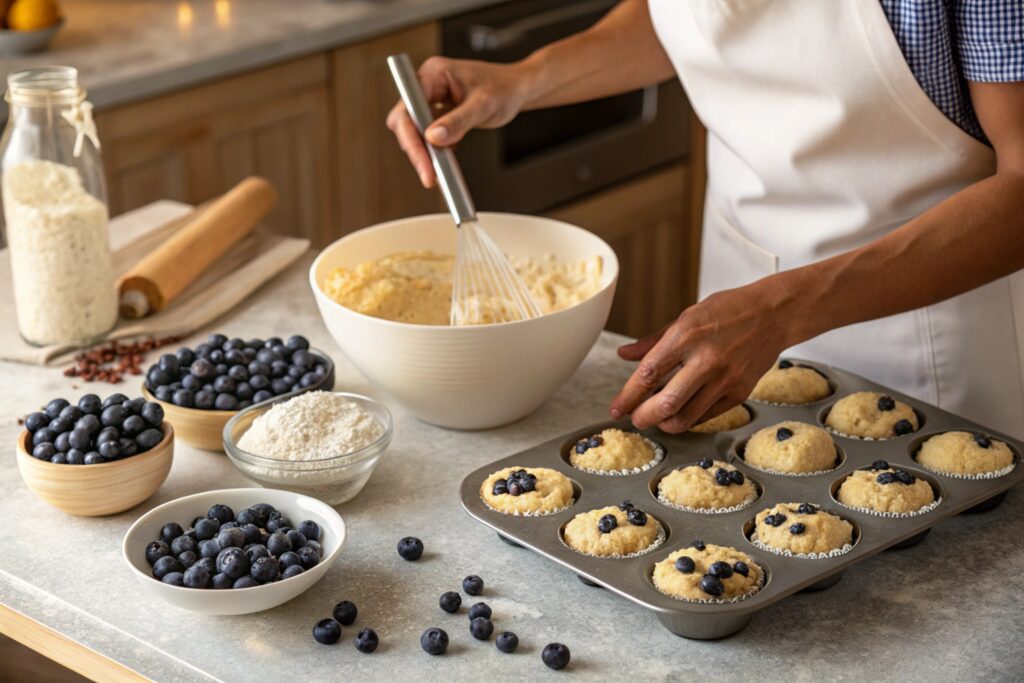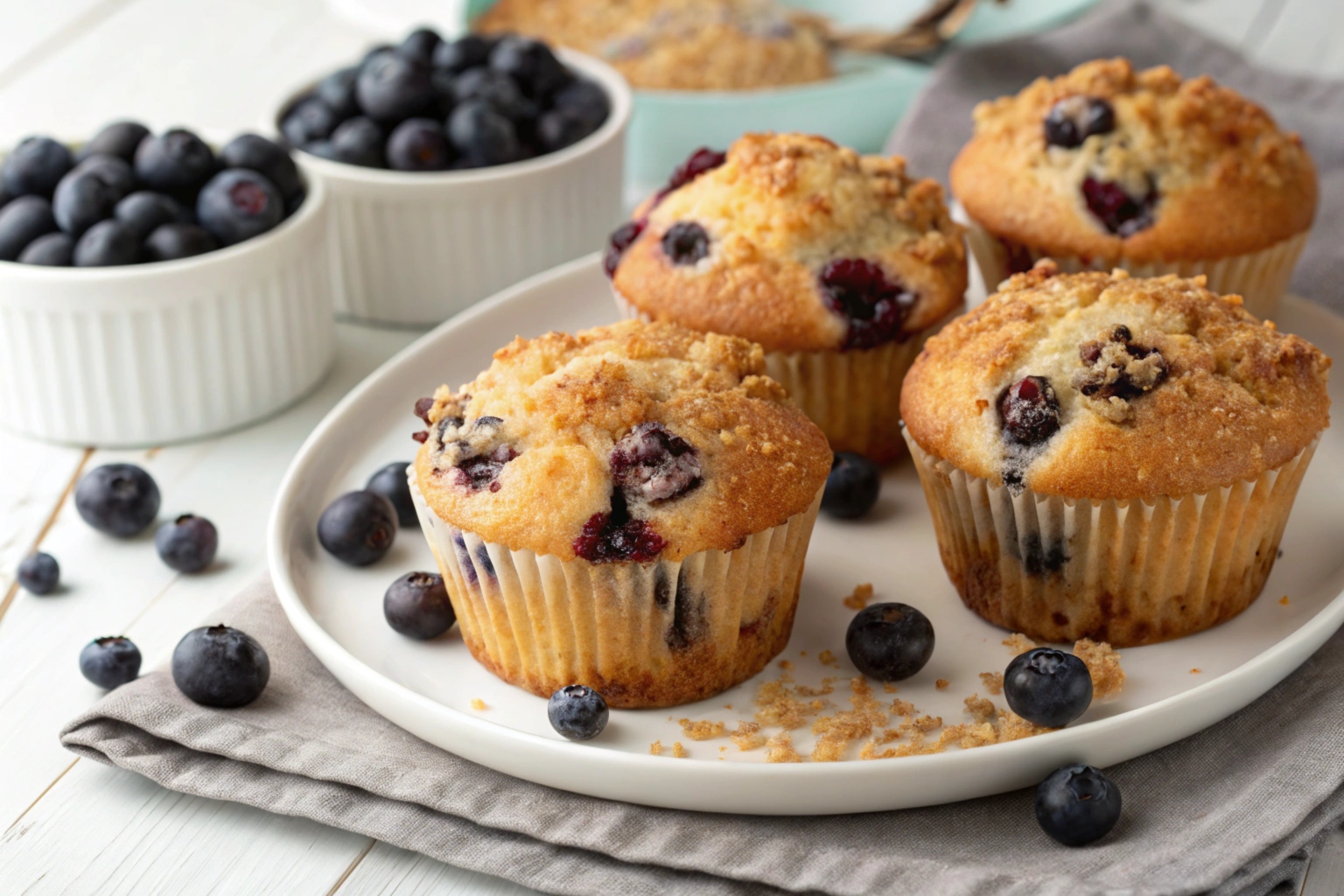There’s something undeniably delightful about bakery-style blueberry muffins. Their golden, domed tops and fluffy, moist interiors make them a standout choice for breakfast or as a comforting snack. While store-bought options can satisfy a craving, nothing beats the aroma of fresh, homemade muffins wafting through your kitchen. This guide will walk you through everything you need to know to create bakery-style blueberry muffins at home—from selecting the best ingredients to mastering the techniques that ensure perfection every time. Whether you’re a seasoned baker or a beginner, these tips, tricks, and recipes will elevate your muffin game to new heights.
Understanding Bakery-Style Muffins
What makes bakery-style blueberry muffins stand out? It’s their tall, domed tops, moist centers, and irresistibly tender crumb. Unlike typical homemade muffins, bakery-style versions have a professional, polished look and an even distribution of juicy blueberries. These muffins often boast a delicate balance between sweetness and blueberry flavor, achieved by using specific techniques and high-quality ingredients. Whether you’re aiming for sky-high muffin tops or that golden brown crust, the secret lies in the details. From ingredient selection to proper baking techniques, every step plays a role in achieving that bakery-quality result.
Key Differences Between Bakery Muffins and Homemade Muffins
At first glance, bakery muffins may seem like ordinary muffins, but the differences are significant:
- Size and Appearance: Bakery-style muffins are often larger, with a golden brown crust and domed tops. Jumbo muffin tins or jumbo liners are commonly used to achieve this size. The visual appeal of these muffins sets them apart, making them a treat for both the eyes and the taste buds.
- Texture: Bakery muffins have a moist crumb, fluffy centers, and a slightly crisp top. This texture comes from balancing wet and dry ingredients perfectly. Achieving this texture requires precision, as too much or too little of any ingredient can drastically alter the result.
- Ingredients: The inclusion of specific elements like sour cream, Greek yogurt, or high-fat European butter elevates bakery muffins. These ingredients contribute to the muffins’ rich flavor and soft texture, making them more indulgent than standard homemade muffins.
- Techniques: Techniques like mixing muffin batter gently to avoid overworking the flour and baking at a high temperature initially help achieve a professional result. Proper handling of the batter ensures that the muffins rise beautifully without becoming dense or dry.
Selecting the Right Blueberries
Blueberries are the star of the show in blueberry muffins, and choosing the right type ensures the best flavor and texture.
Fresh vs. Frozen Blueberries
- Fresh Blueberries: These are ideal for a bright, natural flavor and a firm texture. They work well in muffins with moist centers, as they retain their shape during baking. Fresh blueberries are perfect during their peak season when they’re plump and bursting with sweetness.
- Frozen Blueberries: These are convenient and readily available year-round. When using frozen blueberries, avoid thawing them, as the excess moisture can create soggy muffins. To prevent the batter from turning purple, toss frozen blueberries with a small amount of flour before adding them to the mix.
Organic vs. Conventional Blueberries
- Organic Blueberries: These are grown without synthetic pesticides and often have a more intense flavor. Organic blueberries are an excellent choice if you prefer natural and environmentally friendly options.
- Conventional Blueberries: While typically more affordable, they are still a great option for baking. Washing and drying them thoroughly helps reduce pesticide residue, ensuring a clean and delicious addition to your muffins.
Tips for Preventing Blueberries from Sinking
To ensure your blueberries are evenly distributed throughout the muffins:
- Toss blueberries in a bit of flour before folding them into the batter. This creates a light coating that helps them stay suspended.
- Avoid overmixing the batter, as this can make it too loose for the blueberries to hold. A thick batter provides better support for the fruit.
- Use smaller blueberries or wild blueberries, which are lighter and less likely to sink to the bottom of the muffin cups.
Choosing the Perfect Muffin Pan
The type of muffin pan you use affects the final result:
- Standard Muffin Tins: Perfect for 12 regular-sized muffins, these pans are versatile and widely available. They’re a great option for everyday baking.
- Jumbo Muffin Tins: Great for bakery-style muffins with tall, domed tops. These pans create muffins that are both visually impressive and satisfying to eat.
- Mini Muffin Tins: Ideal for bite-sized muffins and faster baking times, mini tins are perfect for parties or on-the-go snacks.
- Use non-stick cooking spray or muffin liners to prevent sticking and make cleanup easier. Nonstick spray is particularly useful for achieving crisp edges on your muffins.
Essential Ingredients for Bakery-Style Muffins
Flour Types and Their Impact
All-purpose flour is the best choice for muffins, as it provides structure without making the muffins too dense. For a lighter texture, you can sift the flour before mixing it with other ingredients. If you prefer gluten-free options, look for a 1-to-1 gluten-free baking flour that will deliver similar results.
The Role of Sugar in Muffin Texture
Granulated sugar sweetens the muffins and contributes to a tender crumb. For a caramelized flavor, you can substitute part of the sugar with brown sugar. The type of sugar used also affects the color of the muffins, with brown sugar giving a slightly darker hue.
Importance of Baking Powder and Baking Soda
These leavening agents are crucial for creating tall muffin tops. Use fresh baking powder and baking soda to ensure a good rise. Typically, a recipe will call for teaspoons baking powder and a tsp baking soda for balance. Adding an acidic ingredient like sour cream or buttermilk enhances the leavening action, resulting in fluffier muffins.
Flavor Variations for Blueberry Muffins
Adding Mix-Ins for Extra Flavor
While blueberries are the star, adding mix-ins like nuts, seeds, or chocolate chips can elevate the flavor profile. Be sure to adjust the quantities to avoid overcrowding the batter.
Nuts and Seeds
- Walnuts, almonds, or pecans add crunch and nutty flavors. Toasting the nuts beforehand enhances their flavor and aroma.
- Chia or flax seeds provide a subtle crunch and nutritional boost, making your muffins both delicious and wholesome.
Citrus Zest and Spices
- Lemon or orange zest pairs wonderfully with the sweetness of blueberries. Adding zest to the batter or topping provides a fresh, tangy kick.
- Spices like cinnamon, nutmeg, or vanilla bean paste can add warmth and depth. Experimenting with different combinations allows you to create unique flavor profiles.
Techniques for Achieving Tall, Domed Muffin Tops

Proper Mixing Methods
- Combine wet ingredients in a medium bowl and dry ingredients in a separate bowl. Gradually mix them together until just combined. Overmixing the batter can lead to tough muffins, so mix gently and stop as soon as the ingredients are incorporated.
- Avoid overmixing to prevent dense, dry muffins. A few lumps in the batter are perfectly fine and even desirable.
Baking Temperature and Time
- Start baking at a high temperature (425°F) for the first 5 minutes to create steam, then reduce to 375°F for the remaining time. This method encourages rapid rising and helps achieve sky-high muffin tops.
- Bake for 25-30 minutes or until the tops are golden brown and a toothpick comes out clean. Keep an oven thermometer handy to ensure accurate temperatures, as an overly hot oven can burn the muffin tops.
Storing and Freezing Muffins
Short-Term Storage
- Keep muffins in an airtight container at room temperature for up to 3 days. Adding a sheet of paper towel helps absorb excess moisture, preventing sogginess.
- If you prefer warm muffins, reheat them briefly in a preheated oven or microwave before serving.
Freezing Muffins
- Wrap cooled muffins individually in plastic wrap and place them in a freezer-safe bag. They’ll keep for up to 3 months.
- Reheat in a preheated oven or microwave for fresh-from-the-oven flavor. Frozen muffins make excellent grab-and-go breakfast options.
Expert Tips for Perfect Muffins
- Use room temperature eggs to ensure the batter mixes evenly. Cold eggs can cause the batter to curdle, resulting in uneven texture.
- Measure ingredients properly, especially baking powder, baking soda, and flour. Using a kitchen scale for dry ingredients ensures accuracy and consistency.
- Grease the muffin tin or use muffin liners to prevent sticking. Silicone liners are reusable and eco-friendly, making them a great alternative to paper liners.
- For a bakery-style look, sprinkle coarse sugar on top before baking. This adds a delightful crunch and visual appeal.
Tried-and-True Bakery-Style Blueberry Muffin Recipes
Classic Blueberry Muffins
This recipe features a tender crumb, juicy blueberries, and a hint of vanilla extract. Perfect for breakfast or a mid-day treat, these muffins showcase the simplicity and elegance of a well-made classic.
Lemon Blueberry Muffins
Add tangy lemon zest and a splash of lemon juice to the batter for a refreshing twist. These muffins are perfect for spring and summer gatherings, offering a bright, citrusy contrast to the sweetness of the blueberries.
Streusel Topped Blueberry Muffins
A crumb topping made with cold butter, brown sugar, and a pinch of cinnamon takes these muffins to the next level. The buttery sugar streusel creates a crunchy texture that contrasts beautifully with the fluffy muffin base, making these muffins an indulgent treat.
Conclusion
Mastering bakery-style blueberry muffins is all about technique, ingredient selection, and attention to detail. By following these tips and exploring the flavor variations, you can create muffins that rival your favorite bakery’s offerings. Whether you’re baking for a special occasion or simply to enjoy with a cup of coffee, these muffins are sure to impress. With the right tools and knowledge, anyone can create incredible blueberry muffins from the comfort of their own kitchen. Happy baking!


1 thought on “From Mix to Muffin: How to Bake Bakery Style Blueberry Muffins Like a Pro”